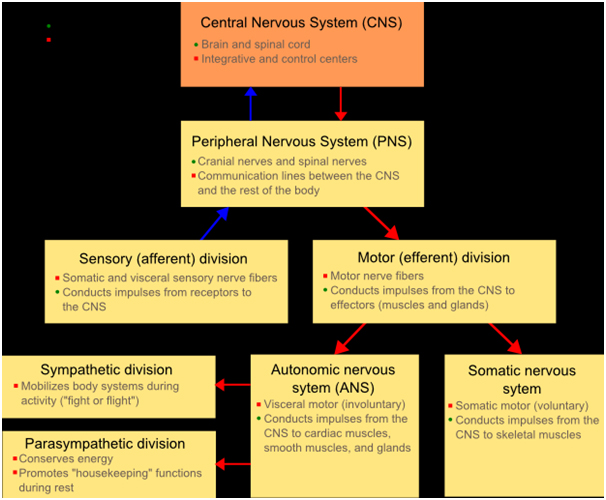NERVOUS SYSTEM
NERVOUS SYSTEM——
The nervous system is a network of specialized cells that communicate information about an organism’s surroundings and itself. It processes this information and causes reactions in other parts of the body. It is composed of neurons and other specialized cells called glial cells,(plural form glia), that aid in the function of the neurons. The nervous system is divided broadly into two categories: the peripheral nervous system and the central nervous system. Neurons generate and conduct impulses between and within the two systems. The peripheral nervous system is composed of sensory neurons and the neurons that connect them to the nerve cord, spinal cord and brain, which make up the central nervous system. In response to stimuli, sensory neurons generate and propagate signals to the central nervous system which then processes and conducts signals back to the muscles and glands.
The Human Nervous System. Red is CNS and blue is PNS.
Nervous system in humans
The human nervous system can be described both by gross anatomy, (which describes the parts that are large enough to be seen with the naked eye,) and by microanatomy, (which describes the system at a cellular level.) In gross anatomy, the nervous system can be divided into two systems: the central nervous system (CNS) and the peripheral nervous system (PNS).

PARALYSIS
Paralysis is a medical condition characterized by the inability to move one or more muscles. In most cases, a person experiencing paralysis also loses all feeling in the affected area. Paralysis may be temporary, depending on the cause. If it is the result of damage to the nervous system, it is usually consistent. Sleep paralysis, on the other hand, only affects a person during the time that immediately precedes sleep or immediately after waking up.
There are many potential causes of paralysis. The two most common causes of paralysis in the United States are stroke and trauma, particularly to the nervous system or the brain. Certain diseases or afflictions, such as poliomyelitis, peroneal dystrophy, spina bifida, amyotrophic lateral sclerosis, Bell’s palsy, Guillain-Barre Syndrome, and multiple sclerosis may also cause paralysis to occur. Botulism, paralytic shellfish poisoning, and certain types of poisons, particularly those that directly affect the nervous system, may also lead to paralysis.
The precise type of paralysis a person experiences depends on the underlying cause. With Bell’s palsy, for example, the paralysis is usually localized, which means it only affects a small area of the person’s body. Typically, only one side of the person’s face becomes paralyzed as the facial nerve on that side becomes inflamed. When only one side of a person’s body is affected, paralysis is considered unilateral. When it affects both sides, it is bilateral.
PARKINSON”S DISEASE
Parkinson’s disease (also known as Parkinson disease or PD) is a chronic and progressive degenerative disease of the brain that impairs motor control, speech, and other functions The disease is named after English physician James Parkinson, who gave a detailed description of it in an 1817 work titled, “An Essay on the Shaking Palsy”.
Parkinson’s disease belongs to a group of conditions called movement disorders. It is characterized by muscle rigidity, resting tremor (typically at about 5 Hz), slowing of movement (bradykinesia) and, in extreme cases, nearly complete loss of movement (akinesia). Secondary symptoms may include high level cognitive dysfunction, subtle language problems, and depression.
In contrast to many other neurological disorders, the nature of the brain degeneration that produces Parkinson’s disease has been well understood for decades. The symptoms are caused by loss of nerve cells that secrete dopamine in a tiny midbrain area called the substantia nigra. These nerve cells, for reasons that are not fully understood, are especially vulnerable to damage of various sorts, including drugs, disease, and head trauma. The term Parkinsonism is used for any process that destroys large numbers of these cells and thereby causes the same characteristic symptoms. Parkinson’s disease, or more fully, idiopathic Parkinson’s disease, is diagnosed when no specific physical cause for the loss of dopamine cells can be identified. This is the most common situation.
ARTHRITIS
Arthritis (from Greek arthro-, joint + -itis, inflammation; plural: arthritides) is a group of conditions involving damage to the joints of the body.
